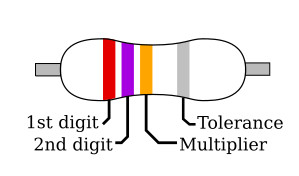Home > Textbooks > Basic Electronics > Resistors > Color Codes >
Resistors
Color Codes
A single standard color code has been adopted for the purpose of identifying the resistance characteristics of fixed resistors of the axial-lead type. In the standard color code system, four bands are painted on the resistor, as shown in the figure below.

The color of the first band indicates the value of the first significant digit. The color of the second band indicates the value of the second significant digit. The third color band represents a decimal multiplier by which the first two digits must be multiplied to obtain the resistance value of the resistor. The colors for the bands and their corresponding values are shown in the table below.
| Color | Digit | Multiplier | Tolerance [%] | Temp. coeff. [ppm/K] |
|---|---|---|---|---|
| None | - | - | 20 | - |
| Silver | - | 0.01 | 10 | - |
| Gold | - | 0.1 | 5 | - |
| Black | 0 | 1 | - | 250 |
| Brown | 1 | 10 | 1 | 100 |
| Red | 2 | 100 | 2 | 50 |
| Orange | 3 | 1000 | - | 15 |
| Yellow | 4 | 10 000 | - | 25 |
| Green | 5 | 100 000 | 0.5 | 20 |
| Blue | 6 | 1 000 000 | 0.25 | 10 |
| Violet | 7 | 10 000 000 | 0.1 | 5 |
| Gray | 8 | 100 000 000 | 0.05 | 1 |
| White | 9 | 1 000 000 000 | - | - |
Precision resistors may use a five band system with three bands for significant digits rather than two. An additional (6th) band indicating temperature coefficient may be also used.
Use the example colors shown in the figure above. Since red is the color of the first band, the first significant digit is 2. The second band is violet, therefore the second significant digit is 7. The third band is orange, which indicates that the number formed as a result of reading the first two bands is multiplied by 1000. In this case 27 x 1000 = 27,000 ohms. The last band on the resistor indicates the tolerance; that is, the manufacturer's allowable ohmic deviation above and below the numerical value indicated by the resistor's color code. In this example, the color silver indicates a tolerance of 10 percent. In other words, the actual value of the resistor may fall somewhere within 10 percent above and 10 percent below the value indicated by the color code. This resistor has an indicated value of 27,000 ohms. Its tolerance is 10 percent x 27,000 ohms, or 2,700 ohms. Therefore, the resistor’s actual value is somewhere between 24,300 ohms and 29,700 ohms.
When measuring resistors, you will find situations in which the quantities to be measured may be extremely large, and the resulting number using the basic unit, the ohm, may prove too cumbersome. Therefore, a metric system prefix is usually attached to the basic unit of measurement to provide a more manageable unit. Two of the most commonly used prefixes are kilo and mega. Kilo is the prefix used to represent thousand and is abbreviated k. Mega is the prefix used to represent million and is abbreviated M.
In the example given above, the 27,000-ohm resistor could have been written as 27 kilohms or 27 kΩ. Other examples are: 1000 ohms = 1 kΩ; 10,000 ohms = 10 kΩ. Likewise, 1,000,0000 ohms is written as 1 megaohm or 1 MΩ.






